
وبلاگ سپهران | Foods | The Best Foods of Armenia | 12 Armenian Dishes and Desserts You Must Try
If you’re planning a trip to Armenia, get ready for an unforgettable experience of flavor and aroma through the best foods of Armenia. Armenian cuisine is famous for the authenticity of its ingredients; most food products in this country are natural and organic. This is what makes every Armenian table welcoming to all tastes — from the aroma of grilled meats to the freshness of herbs and the pure flavor of vegetarian dishes.
In Armenian culture, food goes far beyond satisfying hunger; it represents connection, hospitality, and family traditions. At every celebration, on every table, and within every warm gathering, food holds a special place — from the simple lavash bread to rich, time-honored dishes passed down through generations. From mountain villages to the cozy cafés of Yerevan, the scent of freshly baked bread and warm spices fills the air. In this article from the Sepehran blog, we introduce twelve of Armenia’s national and most well-known dishes — foods whose flavors reflect the history, culture, and identity of the Armenian people.
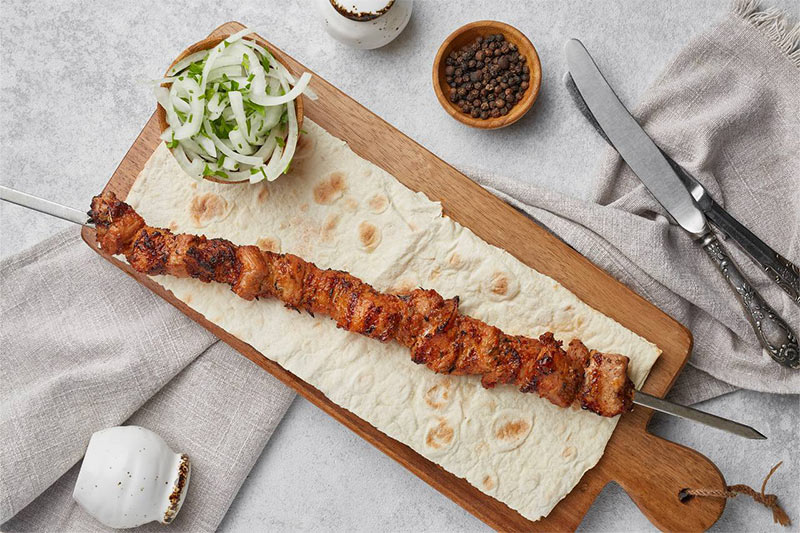
Khorovats is one of the most iconic and best-loved dishes of Armenia — a food that must be present at every Armenian feast or celebration. This fragrant kebab is a ritual of gathering around the fire, deeply rooted in Armenian culture. Pieces of lamb or beef are marinated in a mixture of grated onion, tomato paste, red wine, and local spices, then skewered on metal rods and grilled over hot coals. The sound of the fire, the scent of smoke, and the golden color of the meat are all part of the magic of Khorovats.
Traditionally, Khorovats is served on lavash bread so that the meat juices soak into it. For many Armenians, that flavorful bread is even tastier than the meat itself. There is also a vegetarian version — grilled vegetables and eggplants cooked over the fire, seasoned with local spices. Khorovats carries the taste of fire, but its true flavor comes from togetherness — a simple dish filled with the warmth of life.
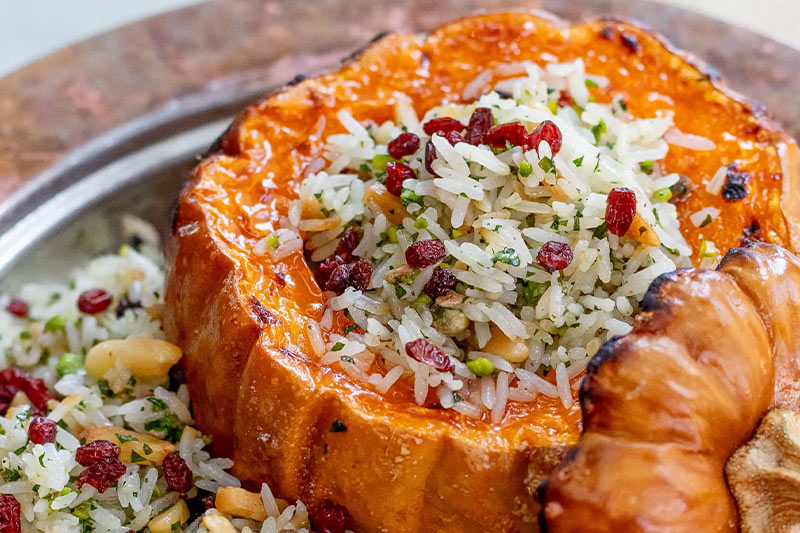
Ghapama is one of the most traditional Armenian dishes, often prepared during festivals and special occasions. It is made from a whole pumpkin filled with cooked rice, dried fruits such as apricots, plums, and raisins, and nuts like walnuts and almonds. The pumpkin is then baked until its shell softens and the aroma of the ingredients blends perfectly. The origins of Ghapama date back to pre-Christian Armenia, when it was prepared as part of harvest thanksgiving rituals.
The word Ghapama in Armenian means “cooked in a closed container.” Beyond its sweet taste and delicate texture, it’s a nutritious dish rich in vitamin A, fiber, and minerals — a symbol of abundance, joy, and Armenian culinary artistry. Ghapama is one of the best foods of Armenia.
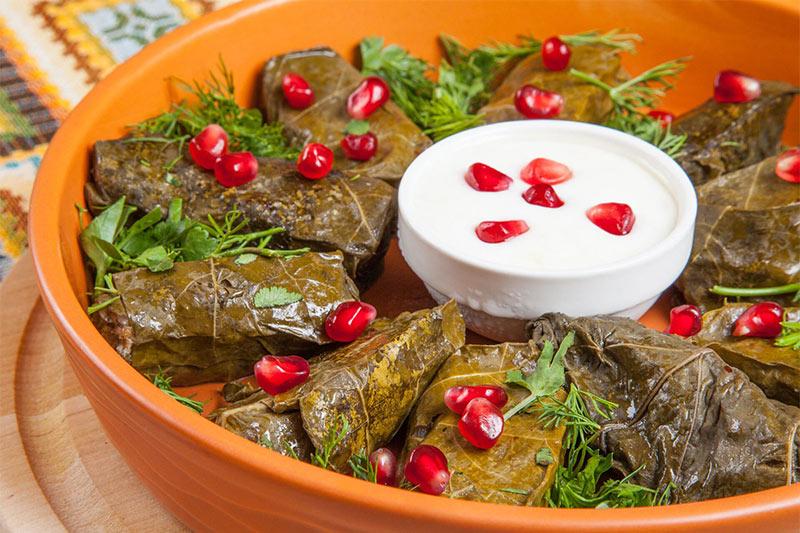
Dolma is one of those dishes in Armenia where the boundary between “food” and “memory” disappears. The word Dolma in Armenian means “stuffed,” which perfectly describes it — a mixture of minced meat, rice, and aromatic spices wrapped in tender grape leaves and slowly steamed in a pot. Besides grape leaves, small bell peppers, tomatoes, zucchini, or eggplants are sometimes stuffed with the same filling.
The difference between meaty tolma and the vegetarian version (known as yalanchi dolma) lies here: meat dolma is served warm as a main dish, while yalanchi, made without meat and based on rice and herbs, is usually served cold as an appetizer.
The filling of meat and rice — often lamb or beef — is seasoned with chopped onion, dried herbs, and a touch of tomato paste. The grape leaves are laid out and filled with care, then arranged in layers at the bottom of the pot, covered with broth or vegetable stock, and gently cooked. Dolma tastes like home — like the kitchens of the past and the aroma of summer, evoking family gatherings and the hands of mothers. Dolma is one of the best foods of Armenia.
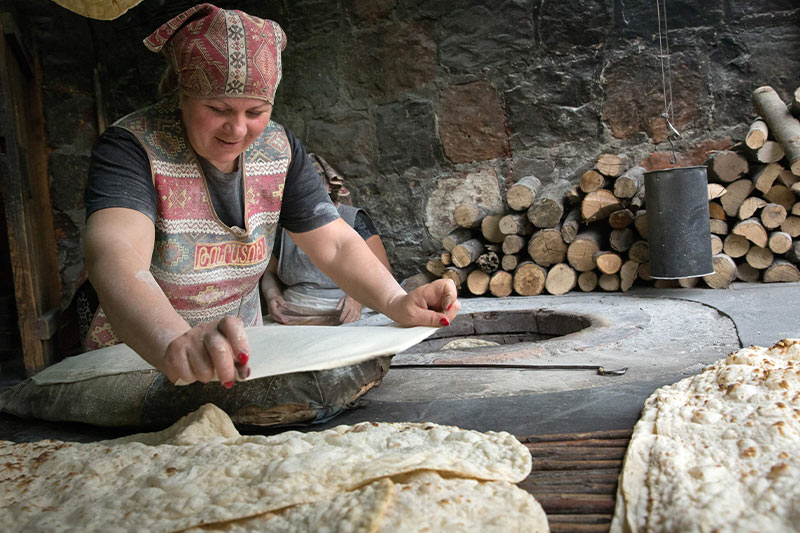
Among all Armenian foods, lavash (or lawash) holds a special place. It’s said that the earliest breads baked by humans were cooked on hot ashes or stones — a method that eventually evolved into thin breads like lavash. Lavash is made from only three simple ingredients: flour, water, and salt. Yet behind this simplicity lies a skill passed down through generations. The dough is kneaded, stretched into a thin sheet about one meter wide, and laid over a soft, round cushion. The baker then slaps it onto the hot wall of a clay oven called a tonir. Seconds later, the bread puffs up, bubbles, and is pulled out with a metal hook — soft, fragrant, and ready for the table.
Across the Caucasus, West Asia, and regions around the Caspian Sea, lavash is one of the most common and beloved breads. In Armenia, Azerbaijan, Turkey, and Iran, it holds a special place in food culture. Cultural connections in this region go beyond music or clothing — food, too, is a vital part of this shared heritage, and lavash is one of its finest symbols.
Lavash can be eaten fresh or dried completely for later use. Once dried, it can be revived with a splash of water and lasts for months. In Armenian homes, lavash is always present — served with khorovats, dolma, or even simply with local cheese and herbs.
In 2014, the art of baking lavash was inscribed on UNESCO’s list of Intangible Cultural Heritage — an honor for a bread that, despite its simplicity, carries the history of the Armenian people.
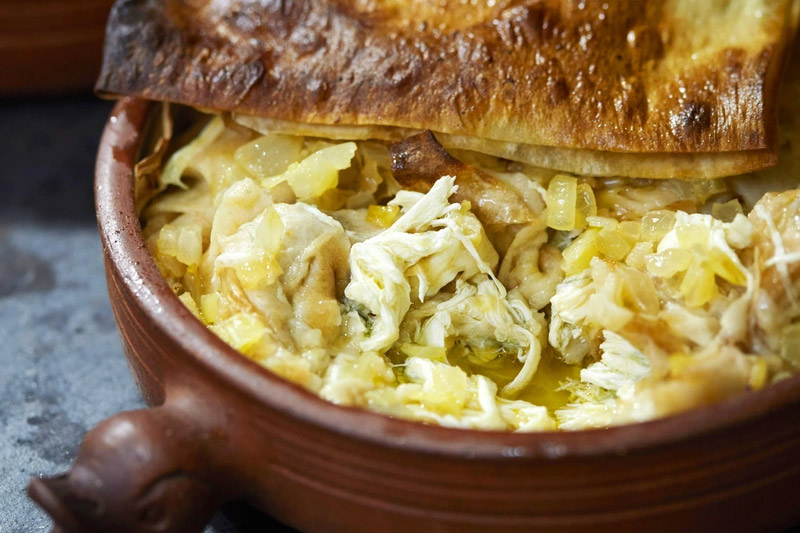
Panrkhash is a traditional homemade dish from the city of Gyumri in northern Armenia, made with a very simple combination of lavash bread, cheese, butter, and onions. This warm, soft dish is a kind of “comfort food,” typically prepared during the cold winter days. To make it, layers of lavash pieces and grated cheese are arranged in a clay or oven-safe dish, topped with hot butter and fried onions, and then moistened with a bit of hot water.
The surface is covered with a piece of lavash and baked until the top turns golden and the cheese inside melts. The result is a tender, aromatic, and satisfying dish — one of the most beloved traditional foods of Armenia for its simplicity and delightful taste. Panrkhash is one of the best foods of Armenia.
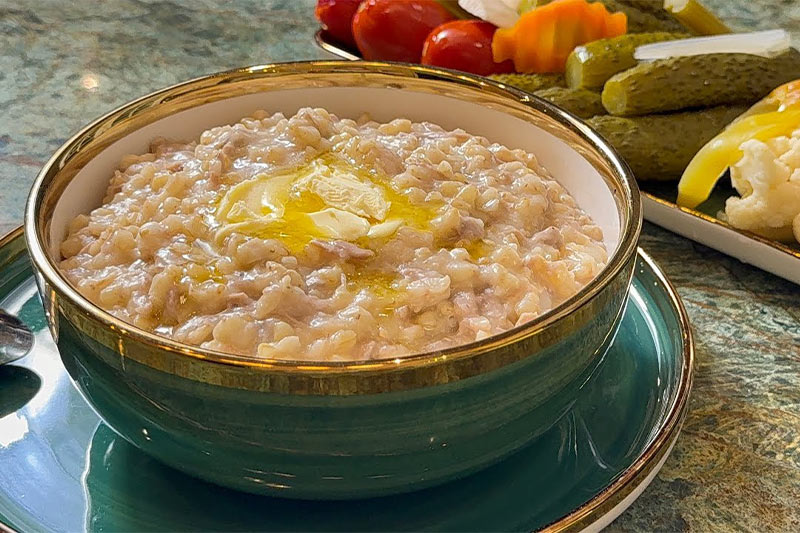
Harissa is one of Armenia’s most authentic winter dishes — a thick, comforting meal cherished both at celebrations and during cold days. This dish, sometimes referred to in historical sources as Keshkeg, is a combination of peeled wheat and chicken or lamb, slowly simmered for hours over low heat until the ingredients completely blend together into a soft, nourishing, and soothing porridge-like meal.
In the past, families would often prepare Harissa for religious occasions or during long winters. Every household had its own version — some used lamb, others chicken or turkey — but the result was always the same: a hearty, nutritious dish that brought warmth to the table.
The secret of authentic Harissa lies in its long cooking time. It must be left to simmer without stirring so that the wheat and meat fully dissolve into each other, creating a creamy texture similar to Haleem, but softer and smoother. When served, a spoonful of local butter and a sprinkle of cumin powder are added to intensify its aroma.
Harissa is usually served with fresh lavash bread, offering a taste that recalls the peace of rural homes and snowy Armenian winters — a dish made from patience, simplicity, and love for life and family.
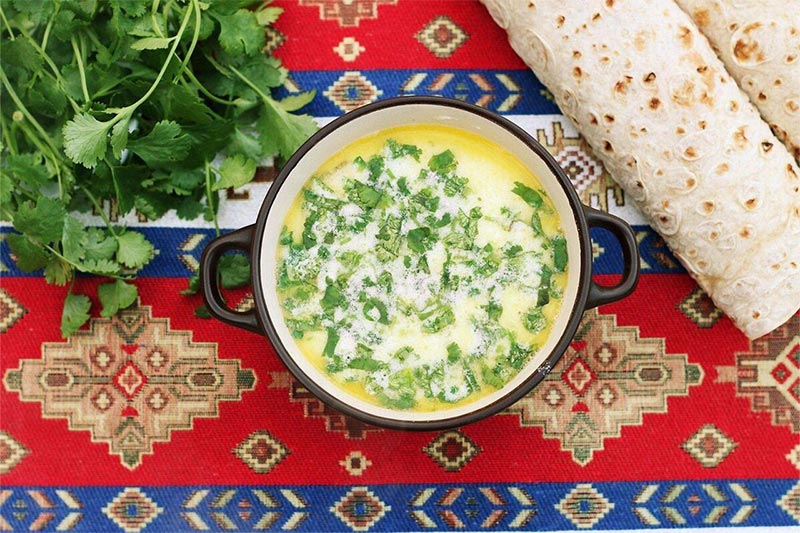
Spas is one of the oldest soups in Armenia — a simple, comforting dish that has graced both rural and urban tables for centuries. It originated in the lives of farmers, where resources were limited and a combination of local sour yogurt, water, and salt created a light yet nourishing meal.
Over time, wheat grains were added to make it more filling, and the final flavor is completed with a touch of dried mint or local herbs. Spas can be served warm in cold winters or chilled in hot summers, and this dual nature has made it one of Armenia’s most beloved traditional dishes. Spas is one of the best foods of Armenia.
Beyond its pleasant taste, Spas offers great health benefits. The wheat used in it is rich in fiber, vitamins, and minerals that aid digestion, strengthen the heart, and boost the immune system. Today, Spas is served not only in Armenian homes but also in restaurants, where visitors find its taste memorable — a soup where every spoonful carries a hint of Armenia’s history and culture.
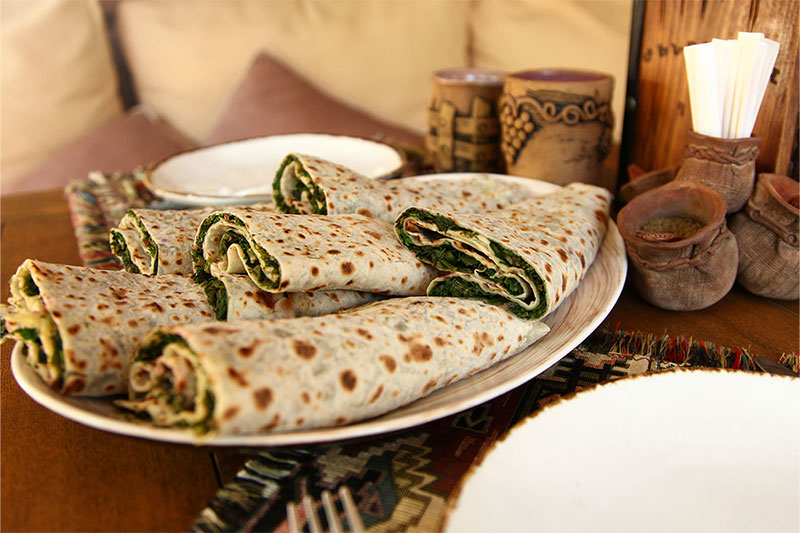
In the lush region of Artsakh, where the earth is rich with the scent of wild herbs, a dish called Zhingyalov Hats was born — a thin, hand-made flatbread prepared by village women and filled with dozens of fresh greens. The word Hats means “bread” in Armenian, while Zhingyalov refers to its rich herbal filling.
This stuffed flatbread is one of Armenia’s most authentic dishes. A mix of local herbs such as parsley, coriander, dill, spinach, tarragon, basil, and even wild mountain leaves gives it a complex, vibrant flavor. The selection of herbs varies by season and region — sometimes up to twenty different types are used in one Zhingyalov Hats.
The dish dates back to times of hardship and famine, when families made nourishing, simple food from whatever nature provided. Zhingyalov Hats was born from that spirit — humble yet rich in flavor and life.
The dough is simple and easy to prepare. After a short rest, it is rolled into a thin sheet, filled with chopped herbs, and sealed before being cooked on a hot griddle or saj until both sides turn golden and slightly smoky. The result is a light, aromatic bread that can serve as a main dish or a healthy vegetarian snack.
Zhingyalov Hats symbolizes the bond between the Armenian people and their land — a food in which every bite carries the taste of sunlight, soil, and mountain herbs.
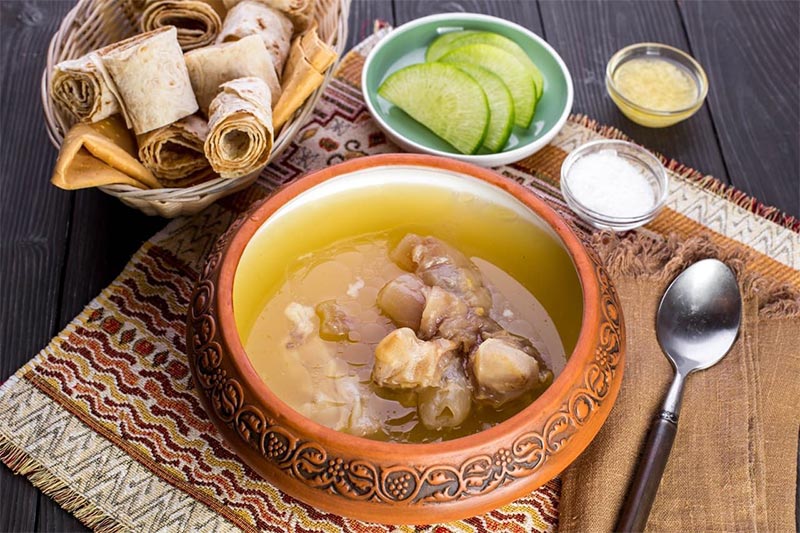
In the cold Armenian winters, when steam rises from the pot and the aroma of fresh meat fills the air, families and friends gather to start the morning with Khash.
Khash is made by boiling cow or sheep feet for many hours. The meat and bones simmer slowly in water until they produce a clear, white broth. No salt is added during cooking — the guests season it themselves while eating, using salt, vinegar, lemon juice, and fresh garlic. Khash is usually served early in the morning, around 9 a.m., and its preparation often begins the night before. It requires precision and patience — cleaning the feet thoroughly, soaking them to remove any strong odor, and then boiling them steadily for several hours. The result is a warm, nourishing, and comforting meal.
In old Armenian traditions, eating Khash was considered a winter celebration. Men would gather around the table, break dried lavash bread into their bowls, and cover it with fresh lavash to trap the steam. Khash is one of the best foods of Armenia.
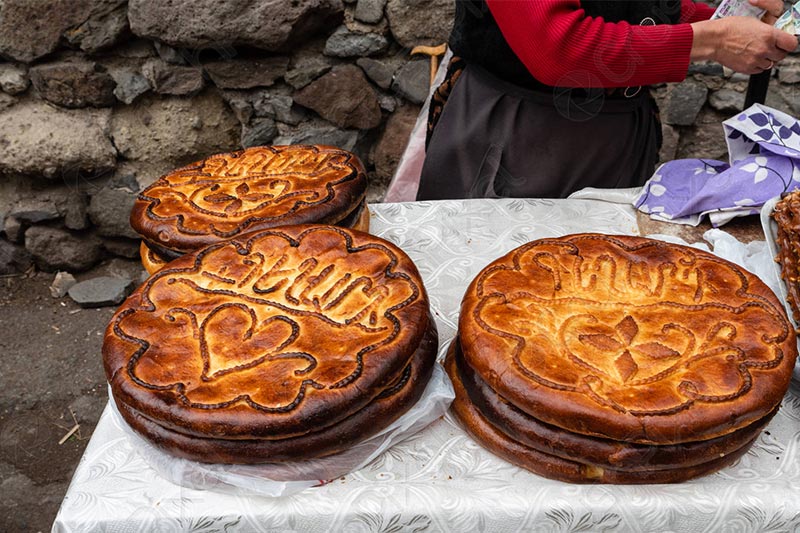
In Armenian culture, Gata symbolizes blessing, festivity, and history. This sweet pastry, made with flour, butter, and a special filling called khoriz, has for centuries adorned the most important ceremonies and festive tables across Armenia. People often call it “the queen of Armenian desserts” or “the jewel of the celebration table.”
The first written reference to Gata dates back to the 13th century, though its true origins are much older — possibly thousands of years, reaching back to the Neolithic era, when humans first decorated ritual breads with sacred patterns.
Archaeological discoveries in Armenia and neighboring regions have revealed stamps once used to imprint designs on ceremonial breads — a tradition that later evolved into decorating Gata. Interestingly, even today, the traditional wooden tool used to carve its surface is called Gatanakhsh in Armenian, meaning “Gata-decorating stamp,” not “bread stamp.”
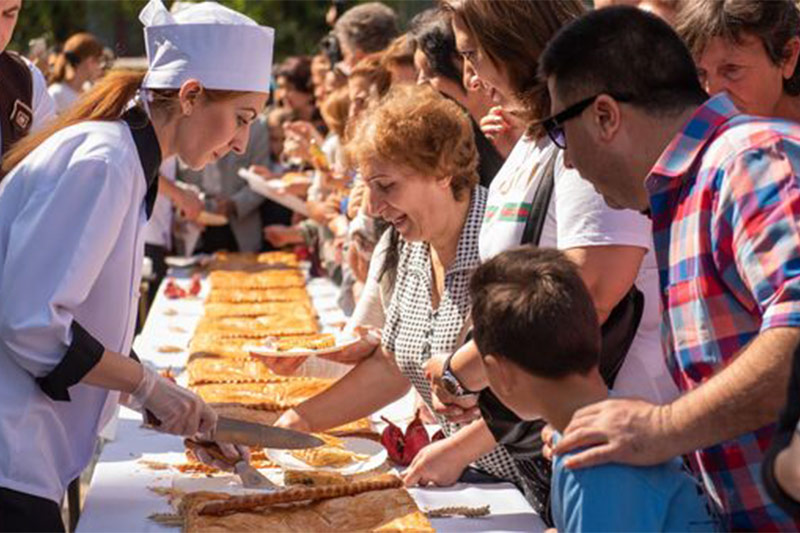
In September 2019, a festival titled “The World’s Largest Gata” was held in Yerevan, the capital of Armenia. The company Yeremyan Projects baked a Gata measuring 65 meters long and weighing 410 kilograms — surpassing the previous year’s size. However, the official Guinness World Record dates back to 2018, when the same company made a Gata weighing 368.60 kilograms, recognized as the largest Gata in the world. The 2019 celebration aimed to honor and surpass that achievement, bringing together locals and tourists around Yerevan’s Karapi Lake as a symbol of Armenia’s pastry-making heritage.
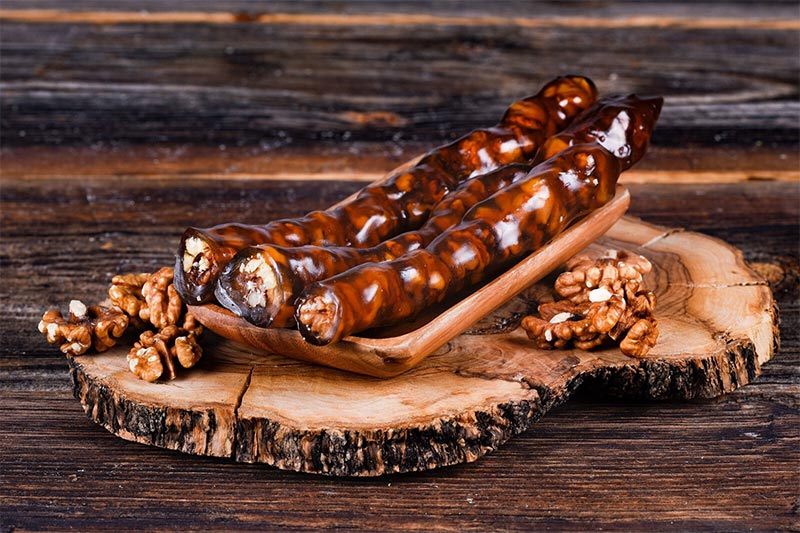
If you’re craving something traditional and unique during your trip to Armenia, you must try Sweet Sujukh — strings of walnuts dipped repeatedly in thickened grape or pomegranate syrup and left to dry until they become glossy and caramel-like. Known locally as Sharots, this dessert looks like a chain of shiny brown beads — visually stunning and full of natural energy.
To make Sweet Sujukh, walnut halves are threaded onto strings, then dipped several times in a thick mixture of grape molasses, flour, starch, cinnamon, and cloves until they are coated in a sweet, aromatic layer. The strings are then hung to dry naturally, forming a texture somewhere between candy and an energy bar.
This dessert is highly nutritious, made entirely from natural ingredients rich in fructose, glucose, protein, organic acids, and vitamins, without any cholesterol or unhealthy fats. Walnuts, especially in this form, are packed with omega-3 and manganese, supporting brain function, reducing inflammation, and promoting heart health. The grape syrup is rich in antioxidants and potassium, strengthening the immune system, improving circulation, and maintaining healthy skin.
In Yerevan, the best place to taste authentic Sweet Sujukh is the famous GUM Market — a colorful, aromatic, and lively bazaar where stalls are decorated with hanging strings of Sujukh. Vendors offer samples with warm smiles, and the taste you experience becomes a sweet memory of Armenian hospitality and culture.
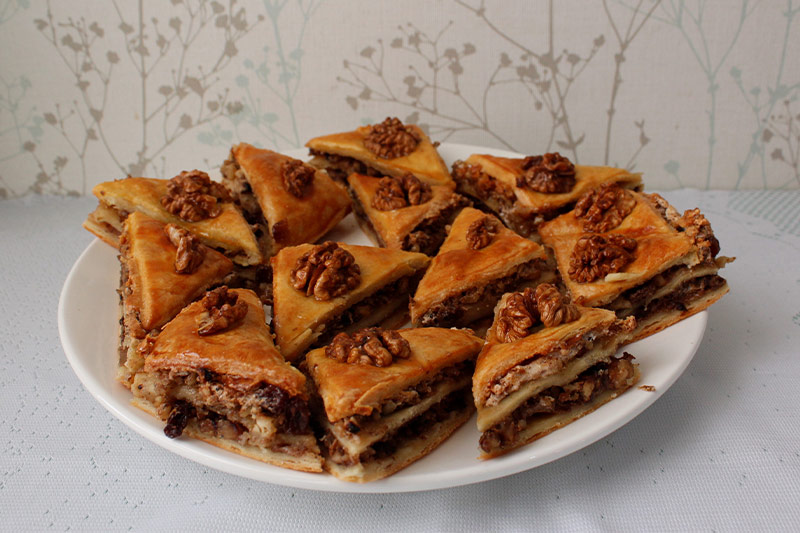
Among Armenian traditional desserts, Baklava holds a special place — a multi-layered, golden, and aromatic pastry that graces every table during Christmas and winter festivities.
Baklava is made with thin filo dough, clarified butter, and walnut filling flavored with cinnamon. The main difference between the Armenian and Greek versions lies in the syrup: while Greeks use honey syrup, Armenians prepare theirs with sugar, clove, and a hint of lemon juice, giving Armenian Baklava a more balanced taste and distinctive aroma.
In many Armenian households, Baklava is baked a few days before Christmas. Large trays are baked in the oven and later shared with friends and neighbors — a sweet gift symbolizing love, kindness, and blessing.
For authentic Baklava, the filo layers are carefully stacked, each brushed with butter. The filling of crushed walnuts, sugar, and cinnamon is spread between the layers, and after baking, hot syrup is poured over the pastry to bind them together. The result is a tender texture, delightful aroma, and unforgettable taste.
Armenian cuisine is a delightful blend of tradition, history, and hospitality — from the thin, symbolic lavash bread listed as UNESCO Intangible Cultural Heritage to the fragrant, sweet Gata that brightens every celebration. Alongside these, dishes such as Khorovats (Armenian barbecue), Dolma (stuffed grape leaves), Harissa, and Sweet Sujukh tell the story of authenticity and everyday life in this ancient land.
If you wish to experience these flavors firsthand and learn more about Armenia’s dining traditions, festivals, and local markets, we recommend reading our Armenia Travel Guide before your trip to discover its culture and everything you need to know before visiting this beautiful country.